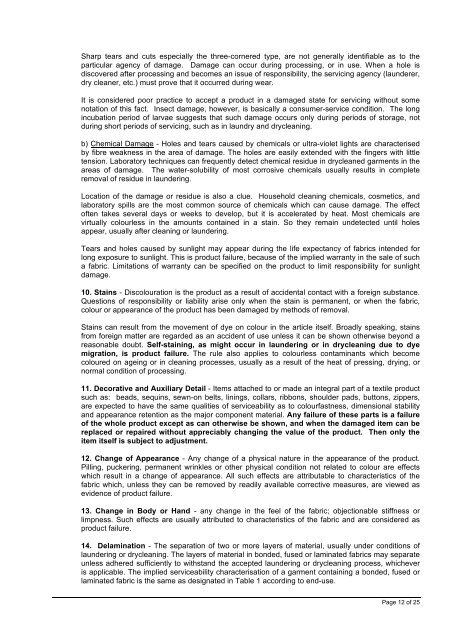international fair claims guide for consumer textiles products
international fair claims guide for consumer textiles products
international fair claims guide for consumer textiles products
Create successful ePaper yourself
Turn your PDF publications into a flip-book with our unique Google optimized e-Paper software.
Sharp tears and cuts especially the three-cornered type, are not generally identifiable as to the<br />
particular agency of damage. Damage can occur during processing, or in use. When a hole is<br />
discovered after processing and becomes an issue of responsibility, the servicing agency (launderer,<br />
dry cleaner, etc.) must prove that it occurred during wear.<br />
It is considered poor practice to accept a product in a damaged state <strong>for</strong> servicing without some<br />
notation of this fact. Insect damage, however, is basically a <strong>consumer</strong>-service condition. The long<br />
incubation period of larvae suggests that such damage occurs only during periods of storage, not<br />
during short periods of servicing, such as in laundry and drycleaning.<br />
b) Chemical Damage - Holes and tears caused by chemicals or ultra-violet lights are characterised<br />
by fibre weakness in the area of damage. The holes are easily extended with the fingers with little<br />
tension. Laboratory techniques can frequently detect chemical residue in drycleaned garments in the<br />
areas of damage. The water-solubility of most corrosive chemicals usually results in complete<br />
removal of residue in laundering.<br />
Location of the damage or residue is also a clue. Household cleaning chemicals, cosmetics, and<br />
laboratory spills are the most common source of chemicals which can cause damage. The effect<br />
often takes several days or weeks to develop, but it is accelerated by heat. Most chemicals are<br />
virtually colourless in the amounts contained in a stain. So they remain undetected until holes<br />
appear, usually after cleaning or laundering.<br />
Tears and holes caused by sunlight may appear during the life expectancy of fabrics intended <strong>for</strong><br />
long exposure to sunlight. This is product failure, because of the implied warranty in the sale of such<br />
a fabric. Limitations of warranty can be specified on the product to limit responsibility <strong>for</strong> sunlight<br />
damage.<br />
10. Stains - Discolouration is the product as a result of accidental contact with a <strong>for</strong>eign substance.<br />
Questions of responsibility or liability arise only when the stain is permanent, or when the fabric,<br />
colour or appearance of the product has been damaged by methods of removal.<br />
Stains can result from the movement of dye on colour in the article itself. Broadly speaking, stains<br />
from <strong>for</strong>eign matter are regarded as an accident of use unless it can be shown otherwise beyond a<br />
reasonable doubt. Self-staining, as might occur in laundering or in drycleaning due to dye<br />
migration, is product failure. The rule also applies to colourless contaminants which become<br />
coloured on ageing or in cleaning processes, usually as a result of the heat of pressing, drying, or<br />
normal condition of processing.<br />
11. Decorative and Auxiliary Detail - Items attached to or made an integral part of a textile product<br />
such as: beads, sequins, sewn-on belts, linings, collars, ribbons, shoulder pads, buttons, zippers,<br />
are expected to have the same qualities of serviceability as to colourfastness, dimensional stability<br />
and appearance retention as the major component material. Any failure of these parts is a failure<br />
of the whole product except as can otherwise be shown, and when the damaged item can be<br />
replaced or repaired without appreciably changing the value of the product. Then only the<br />
item itself is subject to adjustment.<br />
12. Change of Appearance - Any change of a physical nature in the appearance of the product.<br />
Pilling, puckering, permanent wrinkles or other physical condition not related to colour are effects<br />
which result in a change of appearance. All such effects are attributable to characteristics of the<br />
fabric which, unless they can be removed by readily available corrective measures, are viewed as<br />
evidence of product failure.<br />
13. Change in Body or Hand - any change in the feel of the fabric; objectionable stiffness or<br />
limpness. Such effects are usually attributed to characteristics of the fabric and are considered as<br />
product failure.<br />
14. Delamination - The separation of two or more layers of material, usually under conditions of<br />
laundering or drycleaning. The layers of material in bonded, fused or laminated fabrics may separate<br />
unless adhered sufficiently to withstand the accepted laundering or drycleaning process, whichever<br />
is applicable. The implied serviceability characterisation of a garment containing a bonded, fused or<br />
laminated fabric is the same as designated in Table 1 according to end-use.<br />
Page 12 of 25


